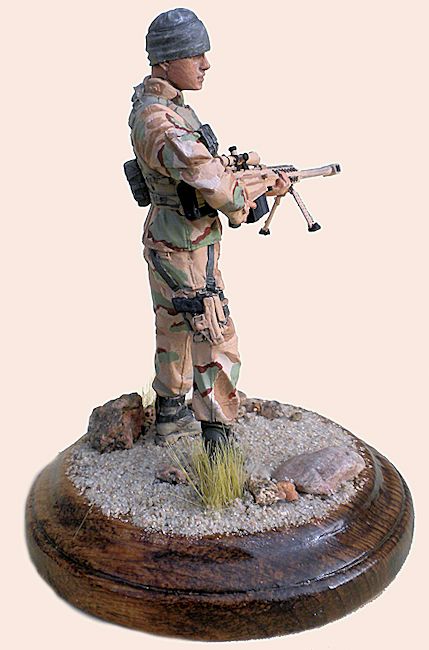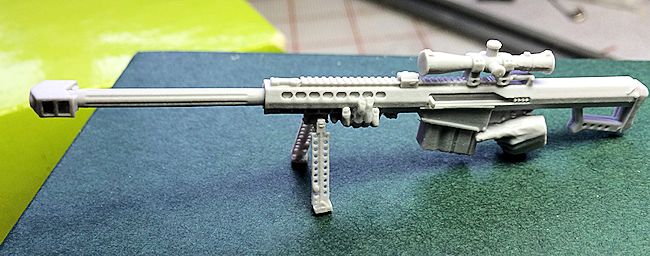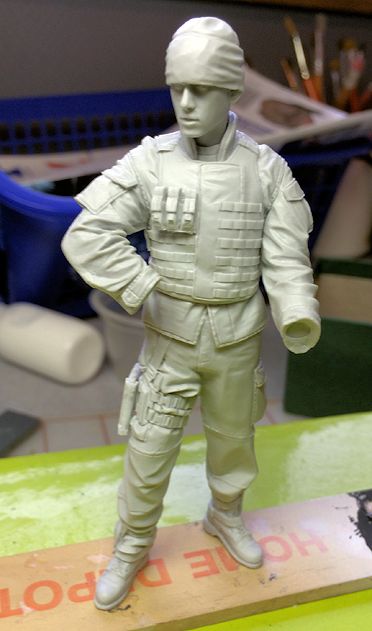
Alpine 120mm USMC Sniper
| KIT #: | ?16008 |
| PRICE: | $55.00 SRP |
| DECALS: | N/A |
| REVIEWER: | Blair Stewart |
| NOTES: | Resin figure |

| HISTORY |
A form of sniping or marksmanship has been a part of
warfare, at least since the American Revolutionary War, or since the invention
of rifling for shoulder-fired infantry weapons. in 1777 at the battle of
Saratoga the Colonists hid in the trees and used early model rifles to shoot
British officers. Timothy Murphy shot and killed General Simon Fraser of Balnain
on 7 October 1777 at a distance of about 400 yards.
The British Army, perhaps having learned an important
lesson in the the revolution, formed a special unit of marksmen during the
Napoleonic Wars. While most troops at that time used inaccurate smoothbore
muskets, the British "Green Jackets" used the Baker rifle. Through the
combination of a leather wad and a rifled barrel, the Baker rifle was
significantly more accurate, but slower to load. The Green Jackets became the
elite of the British Army, and served at the forefront of any engagement, most
often in skirmish formation, scouting out and delaying the enemy.
The term "sharp
shooter" was used in British newspapers as early as 1801.
The term appears even earlier, around 1781, in
Continental Europe, translated from the German Scharfschütze.
 The
Whitworth rifle was probably the first long-range sniper rifle in the world.
Designed by Sir Joseph Whitworth, a British engineer, it used twisted hexagonal
barrels instead of traditional round rifled barrels, which meant that the
projectile did not have to bite into grooves as was done with conventional
rifling. His rifle was much more accurate than the 1853 Enfield. At trials in
1857, which tested the accuracy and range of both weapons, Whitworth's rifle was
able to hit the target at a range of 2,000 yards, whereas the Enfield could only
manage hits at 1,400 yards (still remarkable, when one thinks about it).
The
Whitworth rifle was probably the first long-range sniper rifle in the world.
Designed by Sir Joseph Whitworth, a British engineer, it used twisted hexagonal
barrels instead of traditional round rifled barrels, which meant that the
projectile did not have to bite into grooves as was done with conventional
rifling. His rifle was much more accurate than the 1853 Enfield. At trials in
1857, which tested the accuracy and range of both weapons, Whitworth's rifle was
able to hit the target at a range of 2,000 yards, whereas the Enfield could only
manage hits at 1,400 yards (still remarkable, when one thinks about it).
Despite its success at the trials, the Whitworth rifle
was not adopted by the British Army (politics, perhaps?). However, the Whitworth
Rifle Company was able to sell the weapon to the French Army, and also to the
Confederacy during the American Civil War. Both the Union and Confederate armies
employed sharpshooters. The most notable incident was on May 9, 1864, during the
Battle of Spotsylvania Court House, when Union General John Sedgwick was killed
at a range of about 1,000 yards (910 meters) after saying the enemy "couldn't
hit an elephant at this distance."
During World War I, snipers appeared as deadly
sharpshooters in the trenches. At the start of the war, only Imperial Germany’s
troops had scoped sniper rifles. Although sharpshooters existed on all sides,
the Germans specially equipped some of their soldiers with scoped rifles that
could pick off enemy soldiers showing their heads above their trench. At first
the French and British believed such hits to be coincidental hits, until they
discovered the German scoped rifles. During World War I, the Germans received a
reputation for the deadliness and efficiency of their snipers, partly because of
the high-quality lenses the Germans could manufacture.
The main sniper rifles used during World War I were
the German Mauser Gewehr 98; the British Pattern 1914 Enfield and Lee-Enfield
SMLE Mk III, the Canadian Ross Rifle, the American M1903 Springfield, and the
Russian M1891 Mosin–Nagant.
Between the World Wars, most nations dropped their
specialized sniper units. But World War II quickly brought back the need for
snipers on the battlefield.
During Germany's 1940 campaigns, lone, well hidden
French and British snipers could halt the German advance for significant time
periods. For example, during the retreat to Dunkirk, British snipers were able
to significantly delay the German infantry's advance. This prompted the British
once again to increase training of specialized sniper units. Apart from
marksmanship, British snipers were trained to blend in with the environment,
often by using special camouflage clothing.
One of the best known battles involving snipers, and
the battle that made the Germans reinstate their specialized sniper training,
was the Battle of Stalingrad. Their defensive position inside a city filled with
rubble meant that Soviet snipers were able to inflict significant casualties on
the German troops. Because of the nature of fighting in city rubble, snipers
were very hard to spot and seriously dented the morale of the German attackers.
 n the
United States Armed Forces, sniper training was only very elementary and focused
on being able to hit targets over long distances. Snipers were required to be
able to hit a body over 400 yards away, and a head at over 200 yards. There was
almost no concern with the ability to blend into the environment. Sniper
training varied from place to place, resulting in a wide range of qualities of
snipers. The main reason the US did not extend their training beyond long-range
shooting was the limited deployment of US soldiers until the Normandy Invasion.
n the
United States Armed Forces, sniper training was only very elementary and focused
on being able to hit targets over long distances. Snipers were required to be
able to hit a body over 400 yards away, and a head at over 200 yards. There was
almost no concern with the ability to blend into the environment. Sniper
training varied from place to place, resulting in a wide range of qualities of
snipers. The main reason the US did not extend their training beyond long-range
shooting was the limited deployment of US soldiers until the Normandy Invasion.
The U.S. Army's lack of familiarity with sniping
tactics resulted in disastrous effects in Normandy and the campaign in Western
Europe where they encountered well trained German snipers. In Normandy, German
snipers remained hidden in the dense vegetation and were able to encircle
American units, firing at them from all sides. The American and British forces
were surprised by how near the German snipers could safely come and attack them,
as well as by their ability to hit targets at up to 1,000 yards.
American sniping did not gain much prominence after
World War II until Viet Nam, when Captain Edward James Land pushed the US Marine
Corps to create snipers in every Marine platoon. Land then found Carlos Hathcock,
a country boy from rural Arkansas, who had enlisted in the Marines at age 17,
and quickly demonstrated his prowess with rifles by winning several shooting
matches at Camp Perry and the Wimbledon Cup, the most prestigious prize for long
range shooting.
During the Vietnam War, Hathcock had 93 confirmed
kills of North Vietnamese Army (NVA) and Viet-Cong personnel.
In the Vietnam War, kills had to be confirmed by an
acting third party, who had to be an officer, besides the sniper's spotter.
Snipers often did not have an acting third party present, making confirmation
difficult, especially if the target was behind enemy lines, as was usually the
case.
Hathcock himself estimated that he had killed 300 or
more enemy personnel during his time in Vietnam. The North Vietnamese Army
placed a bounty of $30,000 on Hathcock's life for killing so many of their men.
Rewards put on US snipers by the NVA typically ranged from $8 to $2,000.
Hathcock held the record for the highest bounty and killed every Vietnamese
marksman who tried to claim it.The Viet Cong and NVA called Hathcock
Lông Trắng, translated as "White Feather",
because of the white feather he kept in a band on his bush hat. Until the wars
in Iraq and Afghanistan, Hatcock held the record for the longest kill. Using a
.50cal Browning M-2 (“Ma Duece”) with a 10X Unertl scope, he made a kill at
2,500 yards (1.42 miles).
In the post Viet Nam era, the US military grasped the
value of highly trained snipers, and most of the branches of the service have
sniper training programs and snipers in their ranks. During the wars in Iraq
 and
Afghanistan, United Kingdom and Canadian snipers, armed with some impressive
sniper weapons, pushed the kill distance out over 2,700 yards (1.54 miles).
The
longest confirmed kill record currently belongs to UK Corporal of Horse Craig
Harrison for a shot of 2,707 yards (2,475 meters) in November 2009. Harrison
used an Accuracy International L115A3 rifle and .338 Lapua Magnum ammunition for
this record shot.
and
Afghanistan, United Kingdom and Canadian snipers, armed with some impressive
sniper weapons, pushed the kill distance out over 2,700 yards (1.54 miles).
The
longest confirmed kill record currently belongs to UK Corporal of Horse Craig
Harrison for a shot of 2,707 yards (2,475 meters) in November 2009. Harrison
used an Accuracy International L115A3 rifle and .338 Lapua Magnum ammunition for
this record shot.
Another impressive sniper weapon is the Barrett M82
(or US military designation M107) .50 BMG rifle. The Barrett M107 is a .50
caliber, shoulder fired, semi-automatic sniper rifle. The rifle is said to have
manageable recoil for a weapon of its size owing to the barrel assembly that
absorbs force, moving inward toward the receiver against large springs with
every shot. Additionally the weapon's weight and large muzzle brake also assist
in recoil reduction. Various changes were made to the original M82A1 to create
the M107, with new features such as a lengthened accessory rail, rear grip, and
monopod socket.
Chief Petty Officer Chris Kyle, a US Navy SEAL portrayed in the movie “American Sniper,” had a confirmed kill at 2,100 yards using a McMillan Tac-338 during 2008 Iraqi War operations in Sadr City. Kyle was also the most lethal nipper in US military history with 160 confirmed kills. Iraqi insurgents dubbed him the "Devil of Ramadi" and, like Carlos Hathcock, placed a series of ever increasing bounties on his head, purported to have eventually reached six figures.
| THE KIT |
Alpine Miniatures provides a variety of highly
detailed resin figures depicting various subjects. Taesung Harmms, a figure
sculptor, started the company in 2004.
The company’s main office and workshop are
located in New Jersey, USA.
Cast in 120mm (1/16) scale,
Alpine’s Modern USMC sniper is a great figure kit.
Like most
of these figures, the kit comes in several separate parts and parts attached to
resin casting blocks. The head, arms, torso and legs are separate components, as
are the general’s individual pieces of equipment. The sculpting of the
figu re
is extremely sharp with the great detail afforded by the large 120mm scale.
Alpine’s USMC sniper comes with two heads: one wearing a stocking cap and the
other with the combat (“Fritz”) helmet and chin strap.
re
is extremely sharp with the great detail afforded by the large 120mm scale.
Alpine’s USMC sniper comes with two heads: one wearing a stocking cap and the
other with the combat (“Fritz”) helmet and chin strap.
The kit consists of 16 resin pieces. The model includes equipment such as ammo pouches and a side arm (probably a Baretta M9, which is standard USMC issue, although some US special forces prefer the Sig-Sauer P226). The figure is holding a Barrett M107 .50cal rifle, and the detail on this rifle is extremely good. A plus is that the figure’s hands are molded to the rifle, which reduces the hassle of trying to get arms, hands and rifle all lined up in the final assembly.
| CONSTRUCTION |
I had purchased this kit several years ago, and, like
many of my kits, it went to the “great stash” in the basement, waiting for that
inspirational moment to be assembled. Well, such a moment finally arrived: after
seeing the movie “American Sniper,” I had to assemble and paint this kit! In
deference to Chris Kyle, I opted to paint the figure wearing a US Navy SEAL
desert camouflage uniform (DCU) as worn by CPO Kyle’s character in the movie.
Although CPO Kyle did not use the Barrett rifle in the engagements de picted
in the movie, US Navy SEALS do have the Barrett in their arsenal of weapons, so
I thought it was okay to make this figure into a SEAL
picted
in the movie, US Navy SEALS do have the Barrett in their arsenal of weapons, so
I thought it was okay to make this figure into a SEAL
My first step was to remove the various pieces from
their casting blocks and then clean them up. For the larger pieces, I use a
razor saw to cut the piece off the block, and then a sharp Xacto knife to clean
things up. One can also use a piece of sandpaper on a flat surface to remove the
final casting block resin (exercise caution in doing so: it’s easy to get
carried away with the sanding and sand away more than you want).
Once I did this, I used Super Glue to assemble the
torso, legs and head and arms. When these were dry, I glued the figure to a
wooden paint stirring stick to facilitate handling the model. I assembled the
Barrett rifle separately and put it aside for the final mating of the hands to
the figure.
I then spray painted both the figure and the rifle
with Testors flat white enamel to serve as the base coat and provide a light
base for subsequent painting.
The next step was to paint the figure. For this and my
other figures, I primarily used relatively inexpensive acrylic paints available
from stores such as Walmart and Hobby Lobby.
I first started out with the head. I used a darker shade of flesh tone to facilitate later detailing of the face with lighter shades of flesh tones. I free-handed the DCU markings with small brushes and used pictures of the actual uniform patterns to guide my painting.
| COLORS & MARKINGS |
 Again,
with figures, the major challenge is the skin tones, and then the proper shading
to get some kind of expression on the face. Another challenge for this
particular figure was the light green in the DCU. For this, I used Tamiya
Acrylic XF-21 Sky (don’t ask me why it’s called “sky”), which seemed to be a
reasonable match.
Again,
with figures, the major challenge is the skin tones, and then the proper shading
to get some kind of expression on the face. Another challenge for this
particular figure was the light green in the DCU. For this, I used Tamiya
Acrylic XF-21 Sky (don’t ask me why it’s called “sky”), which seemed to be a
reasonable match.
Once I had painted everything, I mixed some darker
shade paint and then used this to highlight folds in the figure’s DCUs.
I wanted to mount the figure on a base, so I bought a
pre-made wooden one from Michaels. I stained the base with Watco oil, and, when
it was dry, coated it with Future floor polish to get a high gloss finish.
From my current foray into the world of model
railroading, I have learned that nothing looks more like sand and rocks than
“real” sand and rocks, so I went to my Tupperware containers of rocks and
strained sand that I use for scenery. I glued the figure to the basing using
pieces of a paper clip for support, and then spread sand around the top of the
base. I fixed this sand to the base using a diluted solution of white glue. I
fixed the rocks to the base using the same technique.
| CONCLUSIONS |
Again, another pleasant break from my usual modeling.
I highly recommend this kit to those who want to pick a
modern day subject for figure modeling. The figure is a small dedication to the
outstanding snipers of the US Navy SEALs and the US Marine Corps. Thanks for
your service!
| REFERENCES |
1.
Sniper,
Wikipedia, February 2015.
2.
Henderson, Charles,
Marine Sniper, New York: Berkley Books, 1988.
3.
Longest Recorded Sniper Kills,
Wikipedia, February 2015.
4.
Barrett M82,
Wikipedia, February 2015.
5. Chris Kyle, Wikipedia, February 2015.
February 2015
If you would like your product reviewed fairly and fairly quickly, please contact the editor or see other details in the Note to Contributors.